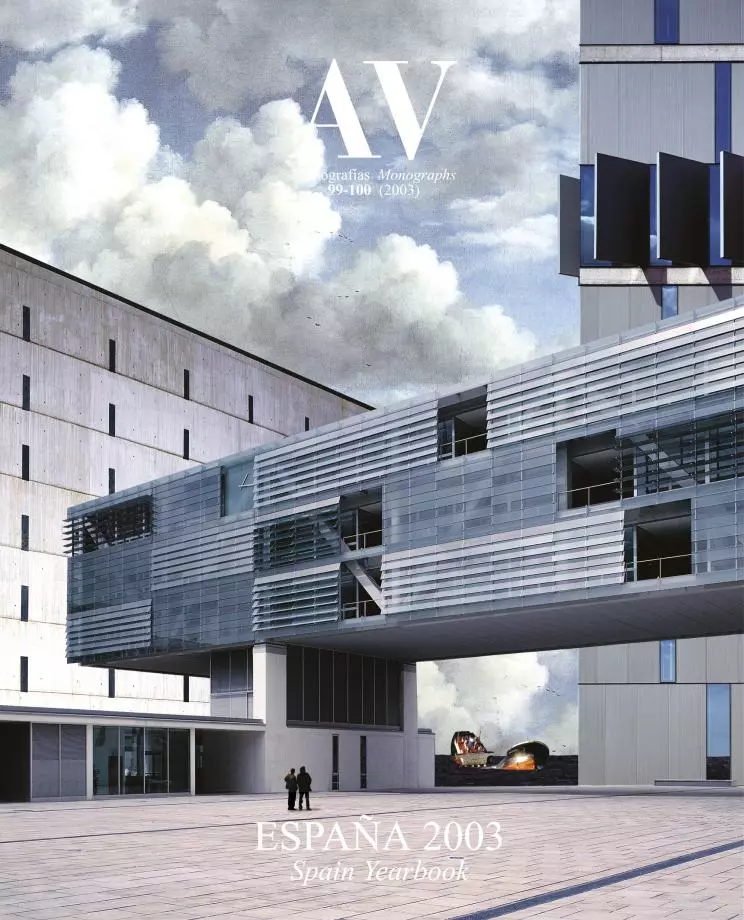Masks of New York
Manhattan inaugurates two cultural headquarters designed by cult architects, the American Folk Art Museum and the Austrian Cultural Forum.

New York is undaunted. In Ground Zero, tears have given way to cameras and calculators. The scene of the tragedy is now a tourist site, and soon it will be a construction site. Designed by the conceptual architects Diller & Scofidio in collaboration with David Rockwell and Kevin Kennon, the first observation platform opened to the public before the year was over, and the huge number of peo-le going for a view of the disaster made it neceesary to regulate access through tickets indicating visit-ing times. Six months after the catastrophe, two provisional commemorative monuments were inaugurated in the vicinity: the deformed remnants of the spherical sculpture by Fritz Koenig that used to stand in front of the World Trade Center; now in-stalled in Battery Park; and two towers of light, conceived by a group of artists and architects, which from a nearby point illuminate the sky with 88 spot-lights. And this June will see the start of works for the skyscraper that is to replace the third building razed on 11 September, #7 WTC, already commissioned by the developer Larry Silverstein – who has rights to the land for 99 years – to David Childs of SOM, the architectural office which is serving as consultant for the entire operation.


Built by Williams & Tsien, and the first new museum raised in the city since the Whitney’s opening in 1966, the American Folk Art Museum gains scale and presence on its narrow plot with a blind facade of unique texture.
In the weeks following the destruction of theTwin Towers, economic uncertainty and fear of travel provoked a crisis of the tourist industry. Museums were affected, and some confronted the drop in num-ber of visitors by offering themselves as places of meditation and refuge in times of anxiety. But the sudden conversion to introspection had vanished by Christmas: the recovery of attendance rates was re-inforced by a handful of inaugurations, and the collective soul-searching was replaced by ‘business as usual.’The Prada store in the Soho building that had been the Guggenheim’s, designed by Rem Koolhaas as a tourist spot, commercial and cultural at the same time, was the most spectacular launching of a fleet that would include the Neue Galerie and the American Folk Art Museum (the first two museums to open in NewYork City since the Whitney in 1966), rounded off on 18 April with the completion of the small tower of the Austrian Cultural Forum.


The New York-based Austrian Raimund Abraham has housed the Forum, a cultural institution of his country of origin, in a sharp zinc tower whose strong image of archaic totem makes up for its small size.
The Neue Galerie is the rehashing of a preexisting building on FifthAvenue’s Museum Mile, almost in front of the Metropolitan and just two blocks from the Guggenheim, executed with exquisite precision by the German-born Annabelle Selldorf to house a formidable collection of early 20th-century Vien-nese and German art, from Klimt and Schiele to Max Beckmann. But both the American Folk Art Museum, designed by Tod Williams and Billie Tsien, and the Austrian Cultural Forum, a work of Raimund Abraham, are altogether new constructions on narrow lots that forced the architects to express their public condition through seductively hermetic facades protecting the constrained faces of the buildings like masks. Both close to the MoMA (the former on the very same block on West 53rd Street, eventually to be embraced on both sides by the extension that Yoshio Taniguchi is carrying out, and the latter on 52nd a few avenues away), the two projects use, despite their radical contemporaneity, for-mal devices of a timeless flavor.
With barely 12 meters between party walls, the Folk imposes its monumental presence on the street by means of a facade whose absence of openings enables one to perceive it without scale. It is built with plaques of a bronze-like alloy that conserves the bubbly texture of the smelt metal, and shaped with delicate folds of origami that delineate cracks of light and make this heavy shell an almost immaterial envelope. Williams & Tsien, a mature marriage of architects that heads a small New York office and has a limited but refined oeuvre behind it, has now carried out its most intense work, with painstakingly detailed interiors where the intelli-gence of the section makes the most of the reduced space and allows toplighting through dramatic ver-tical voids, and an external apparel that reconciles a tactile fascination for craft with a cryptic and colossal Y sign, a Cyclopean letter resembling a drawing by Steinberg that stretches its branch-like arms over an at once innocent and perverse collection of schoolless artists.
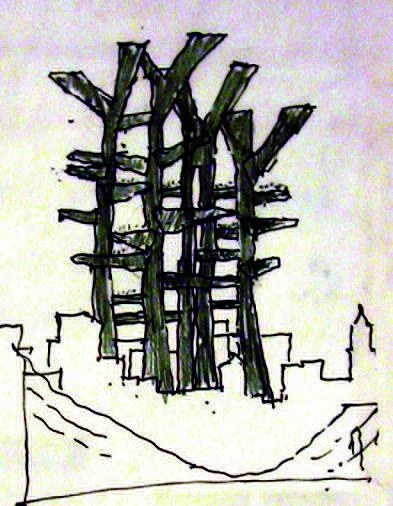
Williams & Tsien
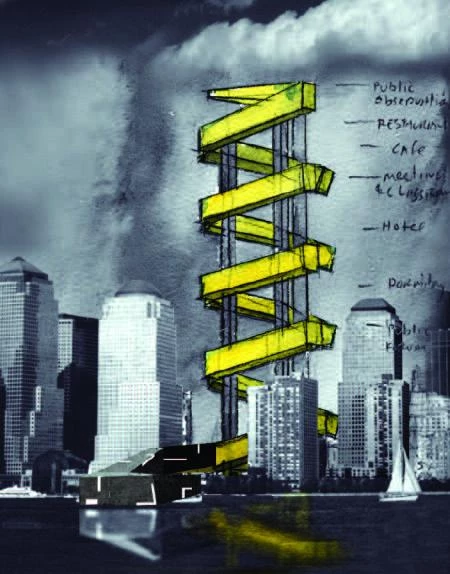
Steven Holl
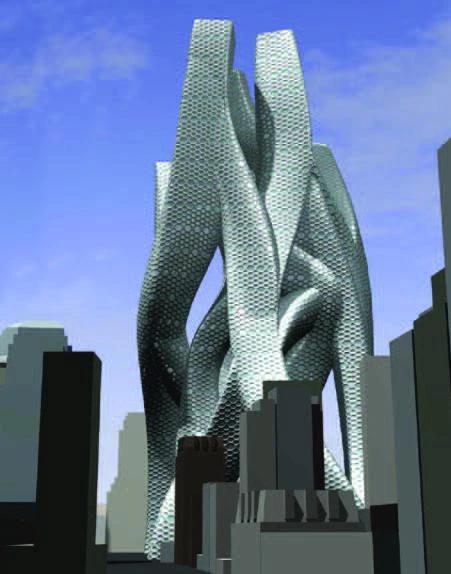
NOX

Zaha Hadid
It was even tougher for the veteran Raimund Abraham, a NewYork-based Austrian who has prac-ticed architecture intermittently as an extension of teaching, a bit in the manner of his colleague at the Cooper Union, the late John Hejduk. In the com-petition that he won ten years ago, over more than 200 compatriots, he had to address an implausible lot only 7.6 meters wide, and finally he came up with a pointed 24-floor tower to house the Forum, a cultural institution under Austria’s foreign affairs min-istry. Leaning on a fire escape scissor-staircase which climbs the rear facade like a backbone, the rigorously symmetrical front facade is set back and inclined to comply with municipal guidelines, ending in a strange totem of anthropomorphic zinc and sharp glass planes, where the ruled exactitude of the metronome confronts the frozen threat of the guillotine, and whose author imagined as a cross between Easter Island and Blade Runner. Diagrammatically designed and summarily constructed, this mini-skyscraper has the ironic force of its near-naïf archaism, and the visionary conviction of a professor and draftsman who one day decided to exchange Wiener Schnitzel for pretzel.

Raimund Abraham
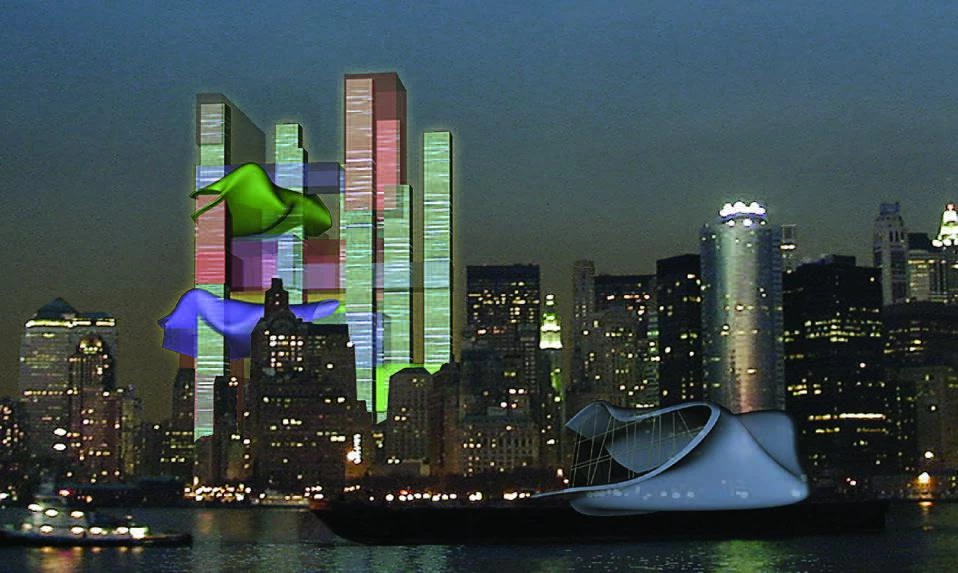
Hariri & Hariri

Hans Hollein
The completion of these two cultural projects is an ambiguous sign of the normalization of NewYork life. A more significant indication of the city’s energetic and amnesic optimism can be found in the proposals that, on the invitation of the Max Protetch Gallery and the magazine Architectural Record, fifty or so architects submitted for Ground Zero, and where many of the profession’s leaders in NewYork unashamedly advocate megalomaniac fantasies. Even the lyrical Williams & Tsien come up with a titanic forest of forked towers that link up fraternally in the dizzying heights, and the otherwise oneiric Abraham formulates a project of solid real estate density, where only the four cracks indicating the sun’s position in the fateful moments of the two impacts and collapses are a symbolic, astral reference: the author of the totem has no fear of the taboo. And while the architects celebrate their lit-tle triumphs and great dreams, Architectural Record publishes a monograph on security in which the guiding thread is that safety measures must be invisible. NewYork may again look like a self-assured city, but 11 September has altered the mood of the United States more than Europeans want to accept. We should have been warned when we saw Woody Allen make it to the Oscar awards, but to hear our American friends complain bitterly about European anti-Semitism, which allegedly blinds us to the Mid-dle East crisis and the Islamic menace, can only produce frustration: this Rome does not listen to Greece. We will keep loving New York and its elegant mask ball, but our respect for an empire that conquers without convincing shall be shattered.

